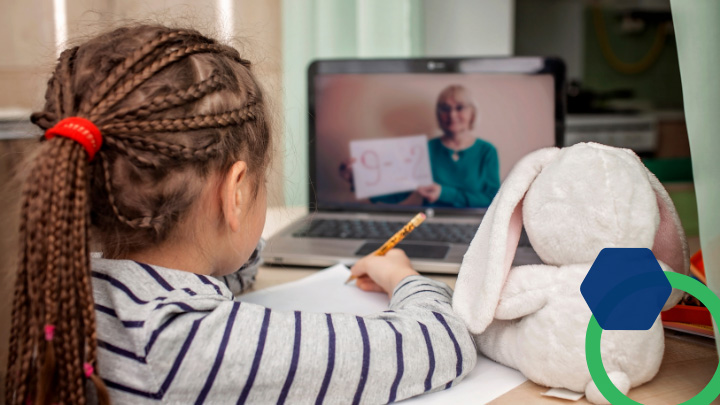Nearly every school system has been thrown into a new relationship with their students’ families due to the COVID-19 pandemic. While parents and other caregivers have always played a vital role in their children’s success, everyone is now navigating a rapidly changing world that includes remote learning. Teachers, school leaders, and district administrators must create new ways to communicate information, partner with families on academics, ensure equitable access to resources, and manage the impact of trauma and fear. Building positive relationships with families forms the foundation of student success.
Based on our experience working with teachers and leaders throughout the country, we’ve gathered some recommendations for teachers and administrators to consider as they continue to build relationships with parents and caregivers to support distance learning.
1. Make Sure Families Know the Distance Learning Plan
When schools first shut down, it was imperative to communicate basic practical information. As time goes on, it’s still helpful to provide families with regular updates, as a part of a Family Partnership Plan. Teachers can consider sending parents a weekly letter or email, and, when possible, perhaps calling the families on the phone to facilitate a more personal connection or follow up with an individual student. You can create a free Google Voice account to connect with families via calls and texts without using your personal number. Alternatively, wifi-based chat apps like WhatsApp can allow families to connect with you quickly on mobile devices over WiFi, without using cellular data. If any of your students’ families don’t speak English fluently, consider using a translation service like Google Translate, Voiance, or Say Hi.
2. Limit the Need for Support from Parents and Caregivers
Parents and caregivers are balancing numerous responsibilities right now, so it’s important to design distance learning activities that don’t require too much support from adults at home. Make sure to provide tools and resources for students to be self-directed in their learning as much as possible. For example, consider creating a “flipped” video for students to watch at their own pace if they need a refresher on key content. When you do need support from family members, make sure to communicate clear expectations, and keep them as minimal as possible.
3. Communicate, Communicate, Communicate!
With remote learning, parents and caregivers may feel especially out of the loop on how their students are doing with school work. Connecting individually with your students’ parents via phone calls or text messages builds relationships with families, ensures the parent/caregiver has the necessary information about their child’s progress, and allows teachers to gain invaluable feedback. In challenging times like the COVID-19 pandemic, it’s particularly important to share highlights of a student’s learning. Check out the Communicating Positive News to Families strategy for more ideas about how to celebrate student learning in a distance learning environment. And of course, when you do reach out to parents, make sure to ask them how they’re doing, too.
4. Support Parents and Caregivers with Tips about At-Home Learning
Every family is different, so it’s important not to make assumptions about what a parent or caregiver needs or what role they will play in their child’s at-home education. However, if a parent asks you for advice, be prepared to share some quick, easy-to-implement strategies to support at-home learning. For example, you might help parents to:
- Set up a schedule: A daily suggested schedule (with plenty of flexibility built-in) can support remote learning, especially if students have limited internet access. For example, parents can plan with students when they will:
- Read for 30 minutes each day (whatever they have — a book, magazine, article, etc.).
- Practice math for 30 minutes each day — do some long division, practice doubling a recipe, or complete a worksheet.
- Engage in another offline learning activity for 1-2 hours.
- Reflect on their learning for 15-20 minutes each day, and send their reflection to their teacher via voicemail, email, or text; or, log it in a learning journal.
- Check in daily: One of the most powerful things a parent or caregiver can do is to simply touch base with their student to see how online classes are going. Having kids at home gives families the opportunity to check in throughout the day. Consider providing a few quick prompts for the parent: “How did your schoolwork go today? Are you learning anything interesting? Was anything challenging? Is there anything you want your teacher to know?”
- Provide space and time for schoolwork: To the extent possible, help parents identify a location and/or time that’s dedicated to school-focused activities. That doesn’t mean a student needs a private desk; instead, consider whether there’s an hour a day where all household members could engage in quiet work, or if there’s a specific time of day where a student could access a shared laptop.
- Know where to turn if a child is struggling: One of the greatest frustrations for parents can be trying to “teach” unfamiliar material at home when their student is stuck or says they don’t understand. Instead of asking parents to provide this support, make sure parents know what to do when their student is stuck: should they contact you? Can they direct their student to a set of online resources? It is helpful for families to know how to direct their child so that they don’t feel like they, too, need to be a teacher.
Building positive relationships with families is never easy, but distance learning can open up some opportunities that teachers, students, and their caregivers may not normally get — like a much richer understanding of what happens in school and at home.








